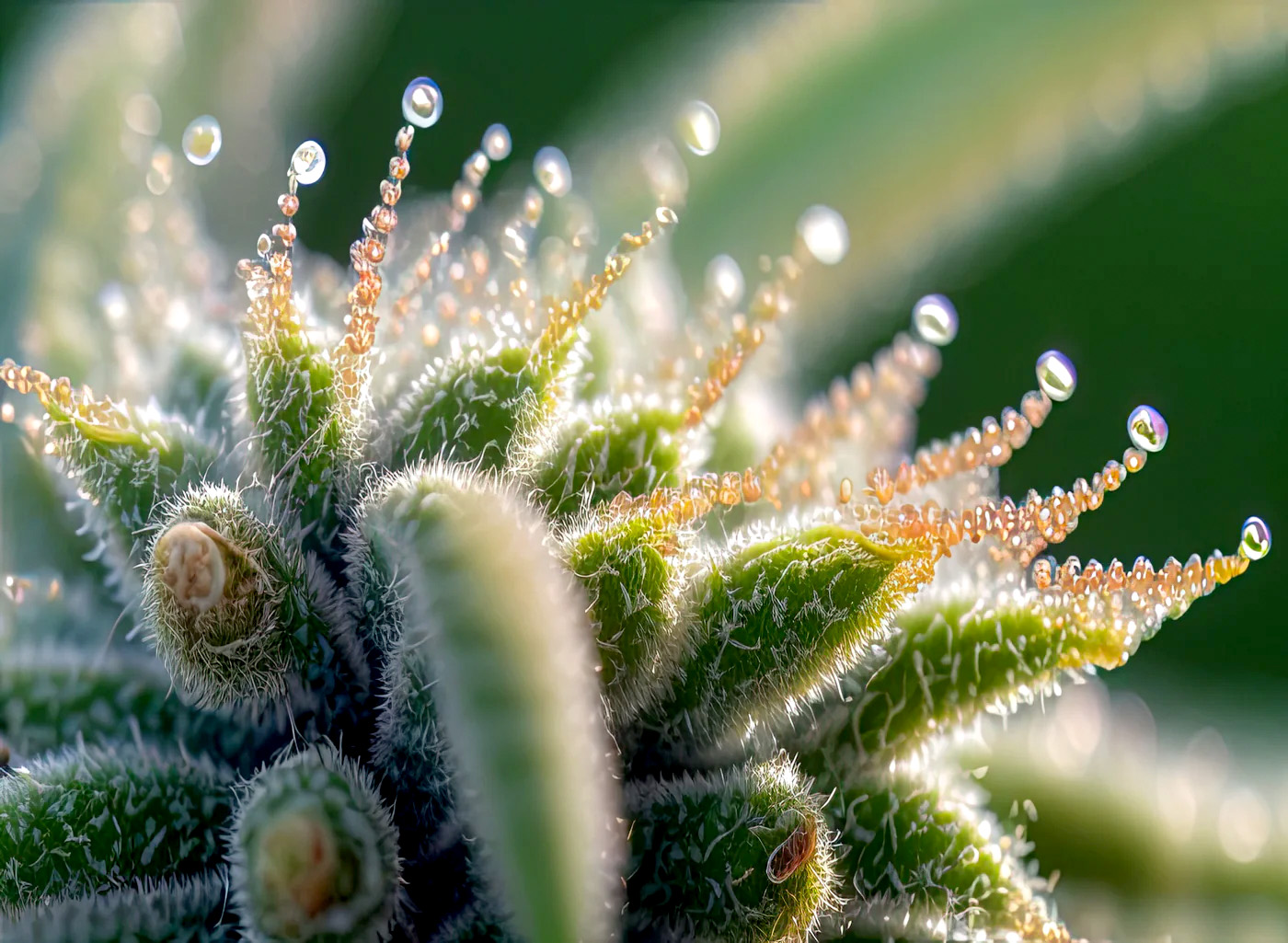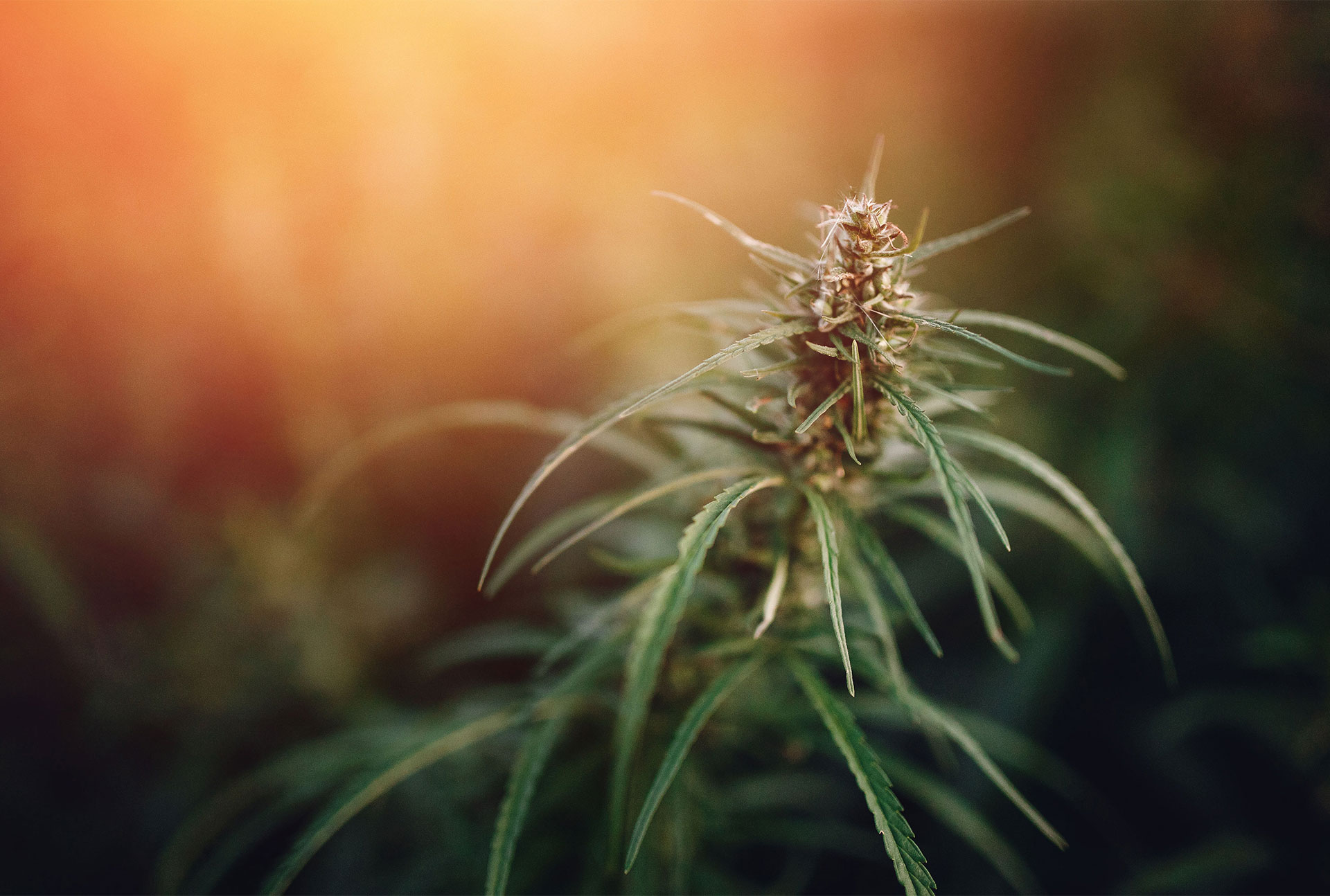
Trichomes aren’t just found in cannabis. The word “trichome” stems from the Greek word tricoma which means “hair.” The official definition of trichomes is “fine outgrowths or appendages on plants, algae, lichen and certain protists.”
When it comes to cannabis, there is quite a bit more than what meets the naked eye. If you fancy the flower, at some point in time you have probably asked yourself about those tiny little crystals that always seems to cover the leaves and buds of your favorite strains. They tend to be shiny, sticky, and always carry the most amazing aromas. Upon looking closer, however, these blankets of frost appear to be large collections of what are known as trichomes.
Trichomes are glands that grow (predominantly) on the flowers and sugar leaves of cannabis plants, and are where cannabinoids and terpenes are produced. These glands produce a viscous resin and coat parts of a cannabis plant during the late flowering stage. Whether you want THC, CBD, or some lesser-known cannabinoid, the trichomes are where you’ll find them.
The production of trichomes can be observed in many species of plants throughout nature, taking on various physical forms as well as serving many different purposes. For example, trichomes found on some carnivorous plants aid in helping to catch prey.
In cannabis, trichomes function as a defense mechanism. When female cannabis plants begin to produce flowers in the wild, they often become vulnerable to various insects and animals as well as non-living environmental variables such as potentially harmful UV rays. Trichomes serve as a deterrent for animals because their bitter taste and strong aromas render cannabis flowers unpalatable. At the same time, they also serve a dual function in protecting their plants from damaging winds and even some varieties of fungal growth.
Trichomes or plant hairs are hair-like structures that occur on the surface of various plants. They usually differ in density, size, and shape. Different trichomes have different jobs and functions. Most serve to defend the plants against pests.
Trichomes are the source of resin and cannabinoids on cannabis plants. They’re small balls of pure cannabis resin. They’re found on all parts of plants. Optimum harvest time can be determined by the appearance and maturity of the trichomes.
For those who grow cannabis for its psychotropic effects, it is the capitate-stalked trichomes that are of interest, as it is these that produce cannabinoids. These trichomes, at close (microscopic) inspection, resemble transparent little mushrooms covering the surface of cannabis buds and sugar leaves (the small leaves surrounding the buds).
At about 150–200µm tall, they’re incredibly small and, to the naked eye, appear as fine, shiny hairs; through a microscope, they appear as thin stalks that lead to a more bulbous head. In fact, the word trichome comes from the ancient Greek “tríchōma”, meaning “hair”. But they are nothing of the sort. As the plant matures, trichomes turn from clear, to milky white, to amber. By keeping an eye on their changing appearance, growers are able to ascertain when best to harvest cannabis.
Trichomes play a major role in the general resilience and health of cannabis plants. They control several physiological processes, such as nutrition intake, hydration retention, and defense mechanisms, by generating cannabinoids and terpenes. Stronger terpene and cannabinoid production is frequently associated with denser trichome covering, which in turn signifies a healthier and more potent plant. Trichomes also assist in preserving the plant’s homeostasis by reacting to stimuli and environmental cues, guaranteeing the plant’s existence and vitality.
You may at this point be wondering why cannabis produces trichomes in the first place. Why would a plant go to all of this hassle to produce something that gets people high? What are the benefits of trichomes for cannabis plants themselves?
In plants, trichomes have actually developed over millions of years to serve a range of purposes.
FOR THE CANNABIS PLANTDifferent types of trichomes serve different purposes on the cannabis plant, but all come together to, unsurprisingly, keep a plant alive and healthy.
One purpose of trichomes is to act as a defence mechanism against the external environment. Dense clusters of shiny, resinous glands help to reflect UV light and protect the plant from extreme light exposure. Moreover, these closely packed growths disrupt the flow of air as wind passes over the plant, and help to prevent excess transpiration, meaning the plant will lose water more slowly. In dry areas, this adaptation can be life saving.
Furthermore, the terpenes within trichomes, as well as the texture of trichomes themselves, can serve to deter predators. With the intense smells being unpleasant to some, and the hairy, sticky texture irritating the mouths of others, trichomes have various tricks to help them ward off hungry pests.
But there’s too much going on inside the glandular trichomes of cannabis plants to be explained purely in terms of deterrence, especially as the plant is already mature by the time trichomes first appear!
For cannabis plants, glandular trichomes may also serve to produce and secrete metabolites that the plants need to survive. These metabolites include:
For growers and cannabis users, trichomes are the single most important part of the cannabis plant. If you consume trichomes by themselves, you can imbibe all the delights and benefits of the cannabis plant. If you consume cannabis plants devoid of trichomes, you might be consuming some greenery, but you certainly won’t get high! Whether you want intense highs, soothing effects courtesy of CBD, or delicious, rich flavours, trichomes are responsible for all of these!
As trichomes are what most growers are after, it makes sense that they are also the best signal by which you should judge when to harvest your weed. THC is at its highest concentration when trichomes are milky white in hue. Therefore, most growers opt to harvest their weed when around 70% of trichomes have become milky white.
As trichomes mature at slightly different rates, finding over 70% milky trichomes is unlikely, so you’ll have to accept that some will be amber, and others will still be clear.
As trichomes contain everything necessary to get high, you can separate them from the cannabis plant to make concentrates. Perhaps the simplest and best-known cannabis concentrate is hashish. Hashish, or hash, is made by compressing kief. Kief is just the name given to a collection of detached trichomes. This kief can then be pressed into a block, making hash.
Other concentrates extract the trichomes using water or a solvent, such as butane. Depending on the extraction method, a different concentrate is created. What they all have in common is that a much larger percentage of their overall mass consists of cannabinoids and terpenes, with some boasting up to 90% THC. As such, concentrates are also considerably more potent than unprocessed cannabis flowers.
It is mainly light and heat that cause trichomes to mature and cannabinoids to change form. Therefore, trichomes can continue to change after harvest if they are exposed to light and heat. As most people don’t want them to change post-harvest, it’s important to keep trichomes cool and out of strong light once you’ve harvested them.
This is why cannabis is dried at mild temperatures of around 20ºC and kept in the dark throughout both drying and curing. If you tried to rapidly dry cannabis flowers at high temperatures, not only would they taste worse when you smoke them, but the trichomes would degrade and have unwanted (or no) effects.
Ideally, if you dry and cure weed properly, then trichomes should change very little after harvest. Indeed, a good drying and curing practice aims to maintain trichomes as they are.
Trichomes are, arguably, the most important part of a cannabis plant (from a user’s perspective). Not only do they contain most (or even all) of the goodness that users want from their plants, but they even tell growers when the optimal moment to harvest is!
As such, understanding cannabis trichomes, how they work, and what their appearance means is crucial to becoming an experienced cultivator. The knowledge itself brings you closer to the plants and the practice of growing, and the application of this knowledge allows you to get the most from your endeavours!
Cannabis sativa is a member of the plant family Cannabaceae. The species name “sativa” is derived from a Latin word meaning “cultivated”. Although the scientific classification of cannabis is still debated, three types are often described: sativa, indica and hybrid.
Sativa-type plants are often described as taller with narrower leaflets, while indica-type plants are shorter with wider leaflets. Hybrid-type plants are the result of crossing sativa and indica plants.
Some consumers report that indica-dominant plants have a more sedating and relaxing effect while sativa-dominant plants have a more energizing one, however these effects have not been scientifically proven.
Cannabis plants contain a number of different types of compounds such as: phytocannabinoids, terpenes and flavonoids.
Phytocannabinoids are part of a class of chemical compounds called cannabinoids. There are two other types of cannabinoids, called the endocannabinoids (produced by our bodies) and synthetic cannabinoids (made by people in the lab to mimic phytocannabinoids). Phytocannabinoids are found in cannabis and interact with the human body to cause the effects experienced when cannabis is consumed. Scientists have identified at least 110 forms of phytocannabinoids. THC and CBD are the most widely known and researched phytocannabinoids known today.
Arguably the most well-known of the phytocannabinoids, THC (delta 9 tetrahydrocannabinol) is the predominant intoxicating molecule in cannabis and gives rise to the euphoria associated with being “high”. THC has therapeutic potential as an analgesic, anti-inflammatory and anti-emetic.1
CBD (cannabidiol) is the second most familiar phytocannabinoid and has rapidly come to prominence in medical applications due to its unique therapeutic profile and effects. CBD is non-intoxicating at therapeutically relevant doses and may reduce pain, anxiety and inflammation1. It has also been found to be a potent anti-epileptic1,2
Terpenes are responsible for the aroma and flavours of cannabis. Terpenes are compounds found in a variety of fruits, plants and flowers that contribute to their flavour, scent and colour.

As nature intended. We’re proud of what we grow. That’s why our expert cultivators craft our cannabis flower by hand, in state-of-the-art Indoor Growing Facility. It’s about quality. PURE TRICHOMES keeps the process natural, and the difference speaks for itself.

We tests every stage of growth in our cultivation process (not just finished flower) to certify that our cannabis is free of synthetic pesticides and PGRs, and that sustainable practices are employed in our facility.